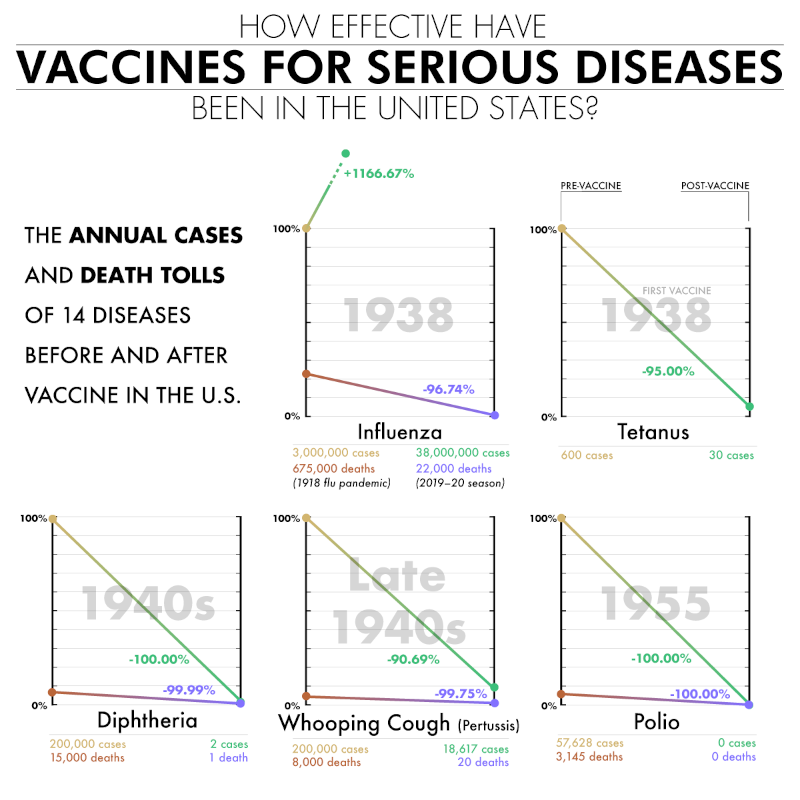Written by Michele Wheat
What would the world be like without vaccines? To imagine this, we must consider how many lives vaccines have saved. Immunization currently prevents around 4 to 5 million deaths annually, many of those children. In fact, more than 1 billion children have been vaccinated over the past decade against serious diseases such as polio, haemophilus influenzae type b (Hib), hepatitis B, measles, mumps, rotavirus, rubella, and tetanus. In fact, in the United States, there are several diseases that have been eradicated by vaccines, such as smallpox, yellow fever, malaria, measles, and polio. To put such a feat into perspective, consider how many people smallpox killed: As one of history’s deadliest diseases, smallpox is estimated to have killed more than 300 million people since 1900. Massive global vaccination efforts made smallpox the first disease ever eradicated. This infographic by the Wristband Resources team explores how vaccines in the United States have saved countless lives.

What Vaccines Are Required for School?
The CDC does not set vaccination requirements for schools or day-care centers; each state decides which vaccines they require in order for children to be enrolled in and attend those facilities. Typically, the vaccines suggested or required by state jurisdictions include the chickenpox vaccine; the diphtheria, tetanus, and pertussis vaccine (or DTaP vaccine); the measles, mumps, and rubella vaccine (MMR vaccine); the polio vaccine; and the hepatitis B vaccine.
The CDC provides a helpful school vaccine checklist to guide parents and caregivers through what vaccines are required by year. The CDC also provides a recommended child and adolescent immunization schedule for ages 18 and younger.
What Is Polio?
Polio is a virus that may cause fatigue, feeling faint, fever, wasting, weakness, headache, nausea, slow growth, and paralysis, which can be fatal in the most severe cases. Polio is spread when the stool of an infected individual is ingested orally, as in through contaminated water or food. When was the polio vaccine invented? The polio vaccine became available in 1955. Thanks to the successful and widespread use of the polio vaccine, the United States was declared polio-free in 1979.
When Common Vaccines Were Invented
When Was the Polio Vaccine Invented? The polio vaccine was made available in 1955.
When Was the Tetanus Vaccine Invented? The tetanus vaccine was made available in 1938.
When Was the Flu Vaccine Invented? The first flu vaccine was made available in 1938.
When Was the Hepatitis B Vaccine Invented? The hepatitis B vaccine was made available in 1986.
When Was the Hepatitis A Vaccine Invented? The hepatitis A vaccine was made available in 1995.
When Was the Rubella Vaccine Invented? The rubella vaccine was made available in 1969.
When Was the Hib Vaccine Invented? The Hib vaccine was made available in 1985.
When Was the Measles Vaccine Invented? The measles vaccine was made available in 1963.
When Was the Whooping Cough Vaccine Invented? The pertussis vaccine was made available in the late 1940s.
When Was the Pneumococcal Disease Vaccine Invented? The pneumococcal disease vaccine was made available in 1977.
When Was the Rotavirus Vaccine Invented? The current rotavirus vaccine was made available in 2006.
When Was the Mumps Vaccine Invented? The mumps vaccine was made available in 1967.
When Was the Chickenpox Vaccine Invented? The chickenpox vaccine was made available in 1996.
When Was the Diphtheria Vaccine Invented? The diphtheria vaccine was made available in the 1940s.